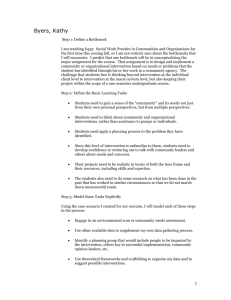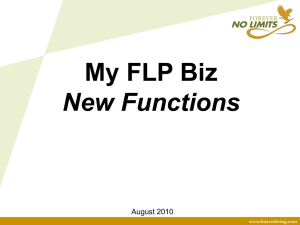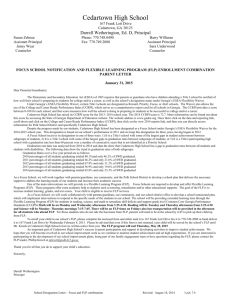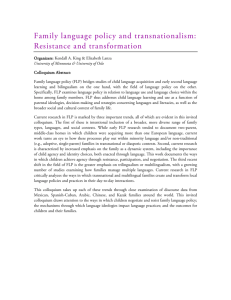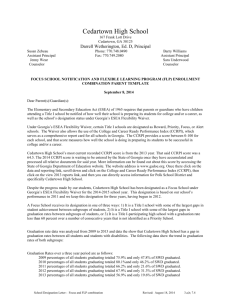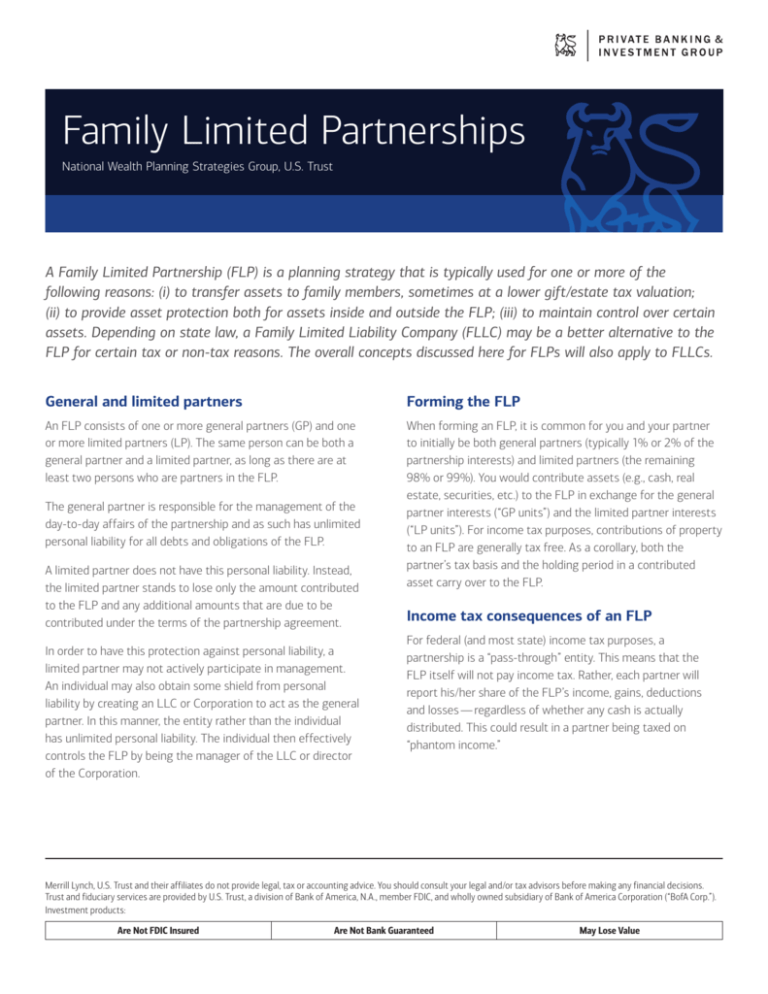
Family Limited Partnerships
National Wealth Planning Strategies Group, U.S. Trust
A Family Limited Partnership (FLP) is a planning strategy that is typically used for one or more of the
following reasons: (i) to transfer assets to family members, sometimes at a lower gift/estate tax valuation;
(ii) to provide asset protection both for assets inside and outside the FLP; (iii) to maintain control over certain
assets. Depending on state law, a Family Limited Liability Company (FLLC) may be a better alternative to the
FLP for certain tax or non-tax reasons. The overall concepts discussed here for FLPs will also apply to FLLCs.
General and limited partners
Forming the FLP
An FLP consists of one or more general partners (GP) and one
or more limited partners (LP). The same person can be both a
general partner and a limited partner, as long as there are at
least two persons who are partners in the FLP.
When forming an FLP, it is common for you and your partner
to initially be both general partners (typically 1% or 2% of the
partnership interests) and limited partners (the remaining
98% or 99%). You would contribute assets (e.g., cash, real
estate, securities, etc.) to the FLP in exchange for the general
partner interests (“GP units”) and the limited partner interests
(“LP units”). For income tax purposes, contributions of property
to an FLP are generally tax free. As a corollary, both the
partner’s tax basis and the holding period in a contributed
asset carry over to the FLP.
The general partner is responsible for the management of the
day-to-day affairs of the partnership and as such has unlimited
personal liability for all debts and obligations of the FLP.
A limited partner does not have this personal liability. Instead,
the limited partner stands to lose only the amount contributed
to the FLP and any additional amounts that are due to be
contributed under the terms of the partnership agreement.
In order to have this protection against personal liability, a
limited partner may not actively participate in management.
An individual may also obtain some shield from personal
liability by creating an LLC or Corporation to act as the general
partner. In this manner, the entity rather than the individual
has unlimited personal liability. The individual then effectively
controls the FLP by being the manager of the LLC or director
of the Corporation.
Income tax consequences of an FLP
For federal (and most state) income tax purposes, a
partnership is a “pass-through” entity. This means that the
FLP itself will not pay income tax. Rather, each partner will
report his/her share of the FLP’s income, gains, deductions
and losses — regardless of whether any cash is actually
distributed. This could result in a partner being taxed on
“phantom income.”
Merrill Lynch, U.S. Trust and their affiliates do not provide legal, tax or accounting advice. You should consult your legal and/or tax advisors before making any financial decisions.
Trust and fiduciary services are provided by U.S. Trust, a division of Bank of America, N.A., member FDIC, and wholly owned subsidiary of Bank of America Corporation (“BofA Corp.”).
Investment products:
Are Not FDIC Insured
Are Not Bank Guaranteed
May Lose Value
Lower gift/estate tax valuation
It is common for the initial partners to make gifts of LP units to
family members (or to trusts for family members). Like all gifts,
the value of an LP unit for gift tax purposes is its “fair market
value” on the date of the gift.
The fair market value of LP units for gift tax purposes is
best determined by a qualified independent appraiser. After
determining the fair market value of the assets within the
FLP, the independent appraiser typically performs an analysis
to arrive at the fair market value of the LP units being gifted.
Often the fair market value of an LP unit will be lower than
the fair market value of the same percentage of the underlying
assets held in the FLP, due to two common discounts — a
minority interest discount and a lack of marketability discount.
Generally, the minority interest discount addresses the
limited control or influence inherent in the transferred LP
units, whereas the lack of marketability discount addresses
the transferred LP units’ non-liquidity. The two discounts are
interrelated because a minority interest tends to be harder
to sell and is therefore less marketable. Depending on the
type of assets owned by the FLP (i.e., securities, real estate,
etc.) as well as the terms of the FLP agreement, courts have
permitted discounts ranging from 10% to 45% of the value
of the underlying FLP assets.
FLP as asset protection strategy
Under most states’ laws, a limited partner has two rights with
respect to the LP units in an FLP: the right to vote (at least
on certain matters) and the right to profits. A creditor cannot
reach a debtor partner’s right to vote, but can reach the debtor
partner’s right to profits.
In order to reach a debtor partner’s right to profits, the creditor
needs to apply to a court for a charging order against the debtor
partner’s units. A charging order means that the general partner
is directed to pay over to the judgment creditor any distributions
from the FLP which would otherwise go to the debtor partner,
until the judgment is paid in full. A charging order does not give
the creditor the right to become a partner in the partnership and
does not give the creditor any right to interfere in the general
partner’s management or control of the FLP. The creditor only
receives the right to any actual distributions that would have
otherwise been paid to the debtor partner.
1
The general partners control the timing of the distributions of
the FLP. If there are no distributions, by virtue of the charging
order the creditor may have to report his share of “phantom
income” on his or her income tax return and pay any taxes due
from other sources.1 This fact has kept many creditors from
asking for charging orders.
Because of these features, an FLP can be used for asset
protection purposes, to shield assets from the creditors of
a donee. For example, if you were to make an outright gift
of assets to an adult child, those assets would be exposed to
the donee/child’s creditors. In contrast, if those same assets
were part of the assets of an FLP and if you made a gift of
LP units to the adult child, the child’s creditors could not reach
the assets but rather could only obtain a charging order as
described here.
Control of FLP assets
If you are the general partner of the FLP, or own an entity that
is the general partner, you would have management control
over the affairs of the FLP, including the right to buy or sell
assets, retain partnership assets or distribute partnership cash
to the partners. Even if you gifted all of the LP units, you would
still control the FLP because of your ownership of the GP units.
To provide even more control over the FLP, the terms and
provisions of the FLP agreement often subject the LP units
to significant transfer restrictions. This means that the
limited partner must follow certain procedures and obtain
other partners’ consent before selling, assigning, gifting,
encumbering, or pledging his or her LP units.
Control, however, can be a two-edged sword. An FLP can give
you a great deal of control over the assets that you contribute
to the FLP. However, this very same control feature can be
used by the IRS to raise estate tax issues for LP units you
gift to family members. Be sure to discuss this with your tax
advisor and be sure that you understand the risks and
potential consequences of retaining control over an FLP.
While this phantom income issue is commonly discussed, there is no clear authority that this would be required. However, the uncertainty still provides a significant disincentive.
FA M I LY L I M I T E D PA R T N E R S H I P S 2
Avoiding IRS challenges to the FLP
The IRS has challenged the gift tax treatment of gifts of LP
units, especially when the FLP is being operated in a “sloppy”
way. In other words, if you set up an FLP but then conduct your
affairs as if the FLP did not exist, the IRS might challenge the
gift tax treatment (by challenging valuation discounts) or the
estate tax treatment (by arguing that the gifted LP units are
still in the taxable estate).
Some actions that could invite IRS scrutiny include:
• The donor/general partner uses the partnership accounts
as his or her own personal checking account (depositing
and withdrawing funds virtually at will) and only “tallies up”
the consequences annually or less often. One of the more
common examples of this is where a donor puts virtually
all of his or her assets into an FLP, so that there are no
funds outside of the FLP with which to pay day-to-day
living expenses.
• Distributions are made to partners in disproportionate
amounts and/or at different times.
• Partnership tax returns are not filed and/or annual state
regulatory filings are not done.
• No official books and records are maintained and/or no
meetings are held.
In addition to challenging FLPs based upon the way the FLP
is operated, the IRS has also challenged FLPs in court on the
following legal grounds:
• Lack of Business Purpose. The IRS has argued that the
FLP should be disregarded for gift and estate tax purposes
because it lacks any valid business purpose. In other words,
the IRS claims that the FLP was created solely for tax
purposes and no discount should be allowed in this situation.
• Retention of Benefits. The IRS has also challenged FLPs
due to the retention of benefits from the FLP, which the
IRS has claimed is the equivalent of owning the underlying
assets. Therefore, the IRS has argued, the full value of the
FLP’s assets should be included in the founding partner’s
estate for estate tax purposes.
• Annual Exclusion. The IRS has challenged a gift of an LP
unit, claiming the gift did not qualify for the $14,000 annual
exclusion because it was not a “present interest.” The IRS
argued that because the partnership agreement imposed
so many restrictions and prohibitions on the LP units, the
donee family members did not have the present ability to
enjoy the property. Proper drafting of the FLP agreement
should address this particular challenge.
These IRS challenges show the importance of having your
legal advisor involved in the creation and operation of an FLP.
Furthermore, when making gifts of LP units, you should retain
an independent appraiser who can support the valuation with
credible, reliable and relevant conclusions. Finally, the FLP
should be operated as a separate, self-sustaining business.
Note: This is not a solicitation, or an offer to buy or sell any security or investment product, nor does it consider individual investment objectives or financial situations.
While the information contained herein is believed to be reliable, we cannot guarantee its accuracy or completeness.
Any examples are hypothetical and are for illustrative purposes only.
Merrill Lynch Wealth Management makes available products and services offered by Merrill Lynch, Pierce, Fenner & Smith Incorporated (“MLPF&S”), a registered broker-dealer and
Member SIPC, and other subsidiaries of BofA Corp.
U.S. Trust operates through Bank of America, N.A. and other subsidiaries of BofA Corp.
The Private Banking and Investment Group is a division of MLPF&S that offers a broad array of personalized wealth management products and services. Both brokerage and
investment advisory services (including financial planning) are offered by the Group’s Private Wealth Advisors through MLPF&S, a registered broker-dealer and registered investment
adviser. The nature and degree of advice and assistance provided, the fee charged, and client rights and Merrill Lynch’s obligations will differ among these services. Investments
involve risk, including the possible loss of principal investment.
The banking, credit and trust services sold by the Group’s Private Wealth Advisors are offered by licensed banks and trust companies, including Bank of America, N.A., member FDIC
and other affiliated banks.
MLPF&S and Bank of America, N.A. make available investment products sponsored, managed, distributed or provided by companies that are affiliates of BofA Corp. or in which
BofA Corp. has a substantial economic interest.
© 2015 Bank of America Corporation. All rights reserved. | ARRPXK3L | Code 102318PPM-0415 | 10% post-consumer content.

